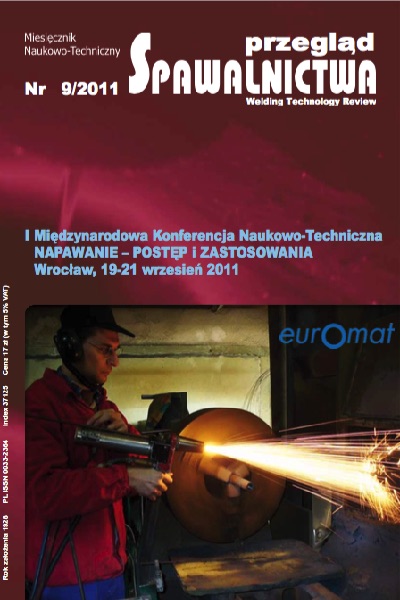System laserowego mikronapawania proszków metali
Main Article Content
Abstract
W artykule przedstawiono technologię laserowego napawania proszków metali oraz opracowaną dla niej obrabiarkę do laserowego mikronapawania proszków. Zaprojektowane i wykonane stanowisko bazuje na trzyosiowej obrabiarce CNC, którą wyposażono w odpowiednie układy bezpieczeństwa laserowego i pyłowego. Jako źródło energii laserowej wykorzystano laser dyskowy sprzężony światłowodem z optyką obróbkową. Szczotkowy podajnik proszków wraz z dyszą kształtującą strumień proszku zapewnia jego podawanie współosiowo z wiązką lasera. Układ został zintegrowany z kartą PC-motion, która pełni rolę sterownika CNC. Przedstawiono również uzyskane wyniki napawania laserowego, charakteryzując je w kryteriach: szerokości i wysokości ściegu, głębokości wtopienia, kąta zwilżania oraz parametrów mikrostrukturalnych. Jako parametry niezależne przyjęto gęstość mocy wiązki lasera, prędkość i gęstość podawania proszku oraz względny posuw głowica-przedmiot.
System for laser microcladding of metal powders
Abstract
The paper presents the technology of laser cladding of metallic powders with a machine for laser microcladding, developed in-house. The designed and constructed set-up is based on a three-axis CNC machine, equipped with appropriate laser safety and a dust extraction system. A disk laser is used as a source of energy, connected with processing optics by a fibre cable. A rotating brush powder feeder transfers the powder to a cladding nozzle, which provides the powder coaxially with the laser beam. The integration of system components is based on a PC-motion card that acts as a CNC controller. Additionally, first results of experiments carried-out on the machine are presented, with characterisation in terms of the cladding height, width and depth, the wetting angle and microstructural features. As independent processing variables the laser power density, the powder feeding rate and the processing speed were used.
Downloads
Article Details
Creative Commons CC BY 4.0 https://creativecommons.org/licenses/by/4.0/
Welding Technology Review (WTR) articles are published open access under a CC BY licence (Creative Commons Attribution 4.0 International licence). The CC BY licence is the most open licence available and considered the industry 'gold standard' for open access; it is also preferred by many funders. This licence allows readers to copy and redistribute the material in any medium or format, and to alter, transform, or build upon the material, including for commercial use, providing the original author is credited.
References
Ehsan Toyserkan, Amir Khajepour, Stephen Corbin, LASER Cladding, 2005 by CRC Press LLC.
F. Lusquiños, R. Comesaña, A. Riveiro, F. Quintero, J. Pou, Fibre Laser Micro-Cladding Of Co-Based Alloys On Stainless Steel, Surface & Coatings Technology 203 (2009) s. 1933- 1940.
L. Dubourg, J. Archambeault, Technological And Scientific Landscape Of Laser Cladding Process In 2007, Surface & Coatings Technology 202 (2008) 5863586.
Wayne Penn, Laser cladding basics, Welding Journal February 2008, Copyright 2008 American Welding Society.
Vilar R., Laser Cladding, The International Journal Of Powder Metallurgy, vol. 37, No. 2, March 2001.
Reinhart Poprawe,Tailored Light2Laser Application Technology. Springer-Verlag Berlin Heidelberg 2011.
Koji Sugioka, Michel Meunier, Alberto Pique, Laser Precision Microfabrication, Springer-Verlag Berlin Heidelberg 2010.
Tomasz Baraniecki, Maksymilain Sidorowicz, Jacek Reiner, System for PS-Laser Micromachining, Proceedings on International Conference Production Engineering 2011, Wroclaw July 2011.
Bernabe Carcel, Jesus Sampedroa, Ana Ruescas, Xavier Toneub, Corrosion And Wear Resistance Improvement Of Magnesium Alloys By Laser Cladding With AL-SI, Physics Procedia 12 (2011) 353-363.
Fraunhofer ILT Annual Report 2007, Fraunhofer Institute for Laser Technology ILT, Micro-Laser Dispersing Of X-Ray Visible Markers On Stents.
Fraunhofer ILT Annual Report 2007, Fraunhofer Institute for Laser Technology ILT, Manufacturing Contact Points On Bipolar Plates For Direct Methanol Fuel Cells.
